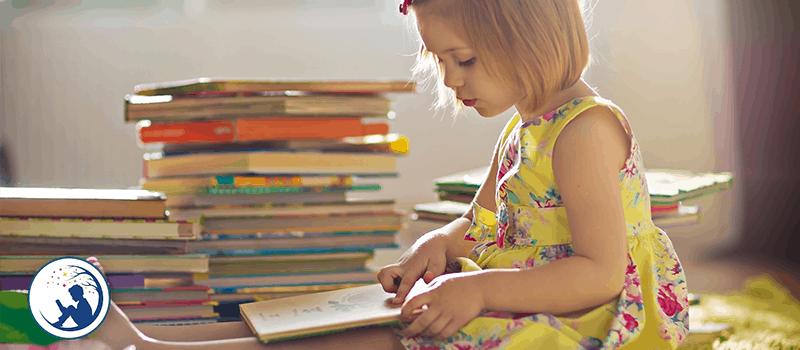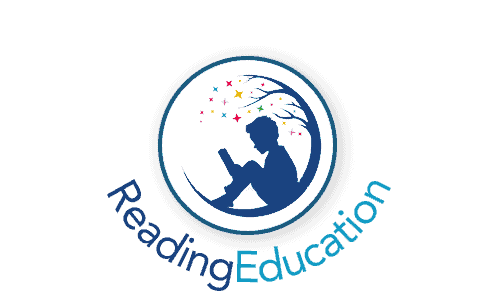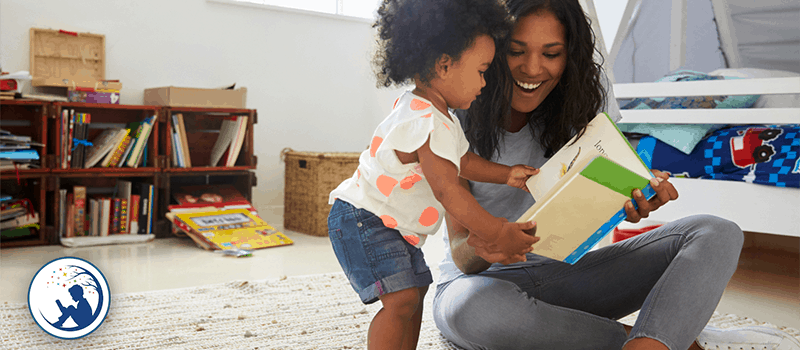As parents, we’re eager to give our children the best start in life. We want their development to be as successful and efficient as possible, and we’ll do anything we can to facilitate this. However, it’s not always easy to know when we should introduce certain aspects of learning to our children, forever asking ourselves, “When is the right age?” or “Is it too early?”. Questions like these are especially relevant to reading. With an abundance of what seems to be conflicting evidence out there, it can often be confusing to know when to initiate your child’s reading journey. Should you start as soon as possible? Should you begin when they start speaking? It really is hard to know when the best time to start helping your child develop their reading skills.
At the age of two, babies are rapidly morphing into children, and their communication skills are evolving rapidly. They will begin to assert their will,
express their personality, and start showing you their preferences. Dramatic improvements in language skills are common, with full, grammatically correct sentences a distinct possibility. It is, therefore, the perfect time to start teaching your little one to read.
The question is, how do you teach a two-year-old to read? Which strategies, techniques, and methods are the most effective? Well, in today’s article, we’ll furnish you with everything you need to know about teaching a two-year-old to read.
Is it possible to teach a two-year-old to read?
Although it may seem odd that we’ve dedicated a whole section to a question we’ve just answered in the introduction above, it is crucial that we address this question in a little more detail simply because so may parents ask it.
Of course, the answer to the question is yes, it certainly is possible to teach a two-year-old to read. However, what’s interesting is the fact that isn’t an awful lot of research into the effects of reading in children of such a young age, which does make people question whether or not two-year-olds are actually able to read. That being said, a quick search on YouTube will present you with a myriad of videos showcasing the reading skills of many a two-year-old!
Of the little research and scientific advice available, it is apparent that when teaching a two-year-old to read, the following advice should be adhered to
- Never force it;
- always use games and activities that your child enjoys;
- understand that every child learns at a different pace, and, as a parent, you should enjoy the process just as much as your child and don’t beat yourself up if it is taking longer than you anticipated.
Should You Teach A Two-Year-Old To Read?
This is another frequently asked question and one that, again, is important to answer. Ultimately, as a parent, it is entirely up to you when you begin your child’s reading development journey. But should you begin at just two years of age?
We’ll level with you; teaching a two-year-old to read isn’t a particularly easy task; in fact, some would describe it as being rather difficult. However, on the flip side, imagine your two-year-old who has only just learnt to speak is able to read phonetically…people will be absolutely amazed! With the correct knowledge and application of said knowledge, it is possible to teach a two-year-old to read, and in most instances, it may only take between 15 and 20 minutes per day.
However, before starting your child’s reading journey, it is vital to educate yourself before commencing. Firstly, learn the fundamentals of phonemic awareness. Although it isn’t difficult for an adult to understand the sounds represented by letters and words, it is incredibly hard for a child who is only two years of age. You will no doubt find it difficult to communicate this knowledge to you child; therefore, having a firm grasp on phonemic awareness is key to not only understanding what it is but also how best to transfer this knowledge to your infant.
Before you begin, it’s wise to assess whether or not your two-year-old is ready to read. In the next section, we’ll examine four clues that will tell you whether or not your child is ready to learn to read.
Is Your Child Ready To Read?
As stated above, it is entirely up to you when you introduce reading to your child; however, here are four clues that may help you decide when to begin. These shouldn’t be taken as gospel though; even if you don’t recognise any of the signs below, it doesn’t mean your child can’t begin to learn to read.
Are they motivated?: It’s very difficult to teach a child to read who doesn’t appear to have any interest in printed words. So what can you do if your child doesn’t seem to be interested in books and words? Read to them! Get books related to the topics they enjoy and make the reading experience as fun and enjoyable as possible. If you make reading fun and interesting, your child’s motivation with skyrocket.
Do they have print awareness?: Print awareness is the ability to understand that the reading involves looking at printed letters/words. If you want to teach your two-year-old to read, it is essential they understand the connection between letters/words and reading. Once your child grasps this concept, they will be able to understand the association between written language and oral language. If your child doesn’t yet have this ability, simply read to them, making sure your point to the words as you read as this will help them to understand the relationship between printed words and what you’re saying. Remember to make it fun! Kids will always prefer to do things they enjoy, so by making learning enjoyable, you’ll instantly make it more appealing.
Do they recognise letters?: Of course, a child must have the ability to recognise letters before they’re able to read; this involves both knowing what a letter looks like and the sound it makes. If your two-year-old recognises letters at an early age, this will better prepare them for learning and development both pre-school and during their school years. If you’re unsure whether your child is able to recognise letters, find fun ways to integrate learning the alphabet and the sounds letter makes into everyday life.
Do they have phonological awareness?: Phonological awareness is the ability to recognise the sounds words make and is often referred to as the foundation of a child’s reading skills. If your child is able to ‘tune in’ to the sounds of words, he or she will likely have some degree of phonological awareness.
How To Teach Your Two-Year-Old To Read: Things To Do

#1 – Read To Your Child Every Day
Reading to your child is by and away, the best thing you can do for them – even if they’re very young. In the beginning, it will help to your infant focus their undivided attention on what’s happening, not to mention building a stronger bond between yourself and your child. As your child gets older, it will help to build strong language skills and overall reading comprehension. In short, reading on a daily basis is the best way to further your two-year old’s development and facilitate learning progression. Remember, babies can recognise your voice when they’re in the womb, so it is never too early to start reading to them. Reading the same books over and over again is absolutely fine; it’s the rhyming and structure of language that should be introduced first.
#2 – Ask Your Child Questions
Learning to read isn’t just about reading books to your child; it requires their input and interaction too. When reading to your little one, ask them questions about the book, what’s happening, who the characters are, and similar questions. The idea isn’t for them to have a complete understanding of a book, merely a basic understanding of the content of the text and the topic in general. It will also help to bolster their vocabulary and understand what words mean. When asking your child questions, always give them plenty of time to respond and never rush them for answers.
#3 – Be A Role Model
Your child’s intrigue and fascination with books and reading will soon evaporate if he or she doesn’t see anyone in your house read, be it via traditional reading mediums such as books and magazines, or on devices such as smartphones, tablets, and laptops. Even if you’re not a prodigious reader, pretend to be one – even if it’s just for five or ten minutes a day. Many parents have the desire to teach their two-year-old to read, yet they themselves aren’t big fans of reading. However, this doesn’t really matter; all you need to do is be seen to be reading – be it a book, a magazine, a menu, a leaflet, on a screen…it all counts! Remember, children love to imitate their parents, so your child is more likely to become a bookworm if they see your reading.
#4 – Utilise All Senses
Incorporating numerous senses throughout the learning progress aids development through the reinforcement of meaningful application and increased retention; therefore, where possible, utilises activities and games that involve more than one sense. For example, learning letter sounds is more important than learning the letters by name; therefore, Involving numerous senses in the learning process will help to not only speed up your child’s development but also reinforce what they’re learning.
If we take the above example – learning letter sounds – there are numerous ways to incorporate several senses to teach this, but letter blocks are one of the most effective. Letter blocks allow your child to see, feel, and hear letter sounds (when you say the letter sounds), which will be more effective than if just one or two senses were involved in the learning process.
#5 – The Word Families Game
The Word Families game is an effective way for children to find and understand patterns in what they read as it helps to bolster their phonemic awareness. Playing the game is straightforward (and fun!) too: tell your child a word (it’s best, to begin with three-letter words that have a consonant-vowel-consonant letter order), then ask them to say as many words as they can that rhyme with that word. For example, if you say “mop”, they’ve got to say as many words that rhyme with “mop” as they can. If they’re struggling, giving them a belong hand, by showing them images, objects or even actions.
#6 – Sight Words
Sight words are by far and away one of the best learning activities for teaching children to learn words quickly and with fluency. When using this method, a child will learn to recognise words but not the letter sounds, i.e. they’re memorising the words because decoding might be a little too difficult for them. This result in your two-year having the ability to instantly recognise the word(s) the instant they see them. Moreover, this is a perfect way for your child to expand their vocabulary. To help boost their speed and fluency, incorporate phonics instruction into the mix.
Teach Your Two-Year-Old To Read: A Summary
Teaching two-year-old children to read is a controversial topic; some argue learning to read shouldn’t begin until later in a child’s life, whereas others are firm proponents of beginning reading development from the day a baby is born. However, what is clear from the evidence is that children who start the learning process earlier typically acquire reading skills faster than children who don’t; therefore, learning from a young age should be encouraged – provided it is fun!

